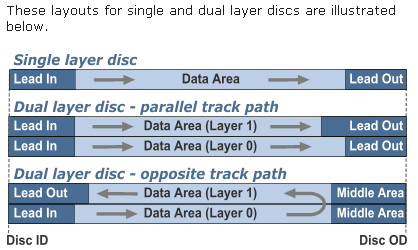CD / DVD Speed Test
When the dvd speed test button is selected the display will change to a display similar to the one pictured below. The plotted green line on the picture below is an example of a dual layer disc. The two red lines mark the layer change point and the end of the disc. The data rate from the drive became faster as it approached the outer edge of the disc in a linear fashion across the disc surface. At the layer change it then became progressively slower as it reached the inner part of the disc again. The right hand boxes give various instantaneous and averaged readings.

This function will allow you to test the speed of your DVD / CD drive on various DVD or CD media types.
Start
This button will start the speed test with the media in the currently selected drive.
Stop
This button allows you to abort the test.
Progress
The associated progress bar for this text below it is a visual progress of the speed test. It is shown as a progressive solid bar and percentage text. Color for these are taken from Windows color settings.
Displays
Graph
The graph displays coloured lines giving the following information.
The Left Vertical graph gives the speed of the drive at a particular point on the disc. The Color of this graph can be set with the Speed Colordrop down list in the Settings dialog..
Depending on the media the scale will change from DVD speed to CD speed. In DVD mode each bright bar represents 2.0x DVD speed (approx 16x CD speed). Each darker bar in between naturally represents 1.0x DVD speed. In CD mode each bright bar represents 10x CD speed and each darker bar naturally represent 5x CD speed.
The Horizontal graph has four scales depending on the media. In DVD mode depending on if the media has 2 layers or 1, and in CD mode depending on if the CD is a 800MB or 1.4GB CD. The scale will automatically change depending on the media.
For single layer DVD’s each bright bar represents 0.5GB of data, In between each bar is divided into five sections with darker bars, each section representing 100MB.
On a dual layer disc the scale is double so each bright bar represents 1.0GB and each smaller section representing 200MB.
On a standard CD the bright bar represents 100MB increments and each smaller section representing 20MB.
On a 1.4GB CD the bright bar represents 200MB increments and each smaller section representing 40MB.
Media Type
The media type field represents the type of media found. It can be, DVD-ROM, DVD-R, DVD-RW, DVD+R, DVD+RW, CD-ROM, CD-R, CD-RW, DDCD, DDCD-R, DDCD-RW, HD-BURN, Unknown, or a blank box meaning an error occurred.
Length
The length field is the size of the formatted media in GB or MB depending on the current media.
Read
The Read field is the amount of data read so far in GB or MB depending on the current media.
Remaining
The remaining field is the amount of data still to be read in GB or MB depending on the current media.
Read Errors
The number of read errors encountered on this media.
Current Speed
This represents the current real time speed of the drive. It is shown in either DVD speed or CD speed depending on the current media. (1x DVD = approx 8x CD)
Average Speed
This represents the average speed since the start of the test. It is shown in either DVD speed or CD speed depending on the current media. (1x DVD = approx 8x CD)
Average Data rate
This represents the average read data rate since the start of the test. It is shown in KBps
Layer Track Path
Each layer of a DVD disc contains lead-in, data area and lead-out like a CD. For dual layer (DVD-9) discs the two layers comprise a single volume, but can be organised in two different ways depending on the application:
Parallel Track Path PTP), where the two layers both start at the inside diameter (ID) and end at the OD with the lead-out. This is suitable for DVD-ROM.
Opposite Track Path (OTP), where layer 0 starts at the ID and layer 1
starts where layer 0 ends. For such discs there is one lead-in (on layer 0),
one lead-out (on layer 1) and two middle areas. This is suitable for DVD-Video
where a single movie can occupy both layers with a layer break in the middle.
Using OTP allows a near seamless jump from layer 0 to layer 1.
